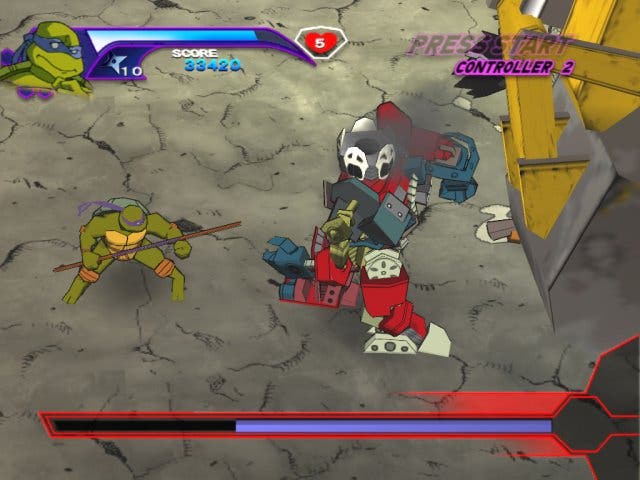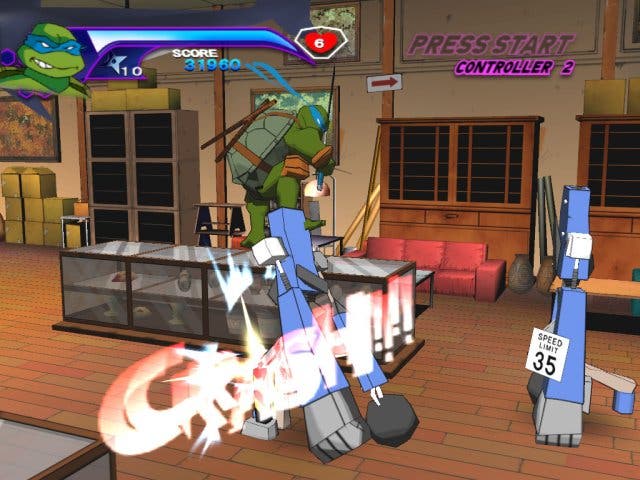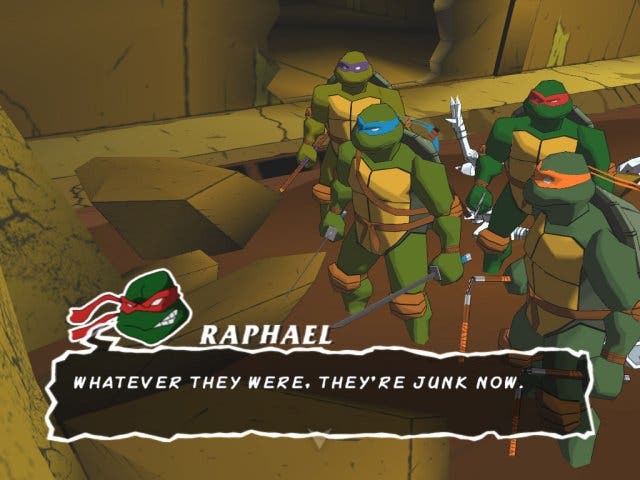Teenage Mutant Ninja Turtles
Remember the Turtles? Sure you do - they were popular back when this sort of game was only vaguely annoying.
Teenage Mutant Ninja Turtles, is it? Ah well. It's easy to get indignant about yet another ticked box on a list of '80s TV shows to plunder, but it's such an inevitability in the current creative vacuum that there's a temptation to just roll with it and see what happens. So we decided we would. Just this once. It only took us until the Konami logo disappeared to realise our mistake, but by then it was too late - we were caught up in an introductory sequence of such piercing dreadfulness that it took us a full 30 seconds afterwards to regain our senses and stem the flood of tears gushing from our disbelieving eyes.
Duuuuuude...

Fortunately, the actual game is less of an affront to the senses, preferring instead to harness ancient mechanics and repeat them until you're so bored that not even an adrenalin shot to the heart would restore your desire to continue breathing. It is basically Golden Axe in 3D, or in fact any other scrolling beat-'em-up of that era (including the long-forgotten TMNT arcade game) in 3D, except not as good as that sounds (if it even sounds good). It's exactly the mechanic you're thinking of - fighting wave after wave of enemies until they disappear, and then moving onto the next screen - except the linear, painted wall-levels can go up and down as well as left and right. What an age it is we live in!
TMNT is basically a game made by people who seem to have discovered 21st century technology, but haven't got past about 1991 in terms of game design. It's a scrolling beat-'em-up made up of six stages, each consisting of overlong individual levels full of identikit enemies, exploding barrels (which you can vaguely send careening around with practice), and all manner of other staples of the old-fashioned genre. Remember arrows with "GO!" written on them? They're back. Remember those revitalising hams in dustbins and barrels? Say hello to pizza in crates!
The idea is simply that you (and up to one friend - as opposed to three in the arcade original) pick your favourite turtle and then journey through each stage slashing at everything in sight with your basic attack moves (weak and strong weapon attacks, an uppercut and a sweep move), vanquish the boss at the end and then celebrate your high score. If you run out of continues during any level of a particular stage, even right at the final hurdle, you have to start again from the very beginning of the stage. Ulp.
Zeroes in a half-shell

Apart from some occasional level-specific features (like timing-based crusher puzzles, or an easily dodged circular saw), it's a game devoid of any noteworthy variety, where you've seen everything of consequence within the first half an hour. You do unlock a couple of new abilities in the occasional Dojo Stage, but they're not exactly going to impress your mates - a jump attack, for example, which lets you, um, attack while jumping. Apparently the Ninja Turtles can only perform this incredible attack - surely comparable to the Herculean feat of walking while chewing gum - after intense training under the watchful eye of master ninja Splinter. Elsewhere, some of the biggest robotic enemies explode violently instead of just fading away, giving you the chance to line up some tactical chain reaction kills, and you can make use of the odd shuriken to vary proceedings, but the former is hardly a saving grace, while the shurikens might as well be shoddy plastic merchandise for all the damage they do.
With nothing except the odd enjoyable cartoon cut sequence or sub-SF2 smash-'em-up bonus stage to break things up, you'll probably lose interest in the combat within an hour or so of picking up the pad, whichever turtle you decide to use. It doesn't help that each level is just a procession of wave after wave of identikit enemies, none of whom is capable of any real tactics or intelligence, preferring instead to ignore you until you move within a certain distance and then periodically launch into attack mode and hope to catch you at a vulnerable angle. Which they do with irritating ease thanks to the lack of a block function.
It also doesn't help that the only real threat is greater numbers of enemies, or that the difficulty curves violently upwards after a while - by spawning greater numbers of enemies (often right in front of your eyes, literally out of puffs of smoke), until your previously bounteous extra lives barely last you to the halfway point of a stage without hours of practice. For a game that you could plough through in about ten minutes if you just had to see every individual element once, the extra repetition is yet another aspect that doesn't help.
The hard cel

If there's something to like about TMNT, it's probably the visuals. The clean-cut, cel-shaded style is backed up by some fairly nice lighting effects, and on the whole there's the right amount of street furniture dotted around to stave off the sensation of running down pointless corridors. Some locations let the team down somewhat - like the junkyard - but the XIII-style overlaying of THOK! and CRASH! and the like across the top of combat helps to build up a good-looking cartoon action scene whatever the background. Pity the decent animations don't get decent collision detection to match, mind.
Sadly though there isn't much else to commend here. The soundtrack and sound effects are utterly dire - you won't believe how annoying a simple "OK" button noise can become - and although you could argue there's lots of replay value here, you'd have to convince us that it's worth bothering with in the first place before we paid attention. There's a Vs mode, but the limited combat and 3D environments don't lend themselves particularly well there either.
Played co-operatively, TMNT isn't quite so hateful, and could quite happily fill an evening - as long as you can find something interesting to talk about over the top - but the lack of four-player support is just another nail in the coffin. Then again, multi-taps were uncommon back when the ideas behind TMNT were actually conceived, and a four-port console was unheard of, so perhaps this is just some warped vision of consistency...
April showers (actually she doesn't)
To be fair, Teenage Mutant Ninja Turtles isn't a badly made game. Everything it sets out to do, it does. It's not bad because it's unplayable. It's bad because everything it sets out to do feels 15 years old, or frustrating and repetitive. All you do is mow down endless waves of respawning enemies packed in between invisible walls, and then shuffle on to the next section and do the exact same thing. It has the same impact now that a Doom engine first-person shooter would have if it were to go up against Half-Life 2. It's also one of those increasingly rare occasions where you imagine the Game Boy Advance game probably isn't all that different to the console version.
Ironically, in climbing into bed with the folks behind the current Turtles revival, Konami has resorted the exact same tactic - recycling an old recipe in the hope of spinning a few quid out of the hapless or nostalgic punter. It's a feat of dastardliness worthy of the Shredder himself, and hopefully just as ill fated as anything he ever dreamt up.










